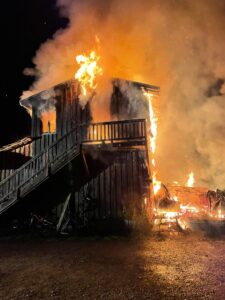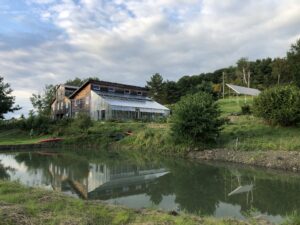Stress Management Through… a Decision-Making Framework?
Farmers are particularly susceptible to both chronic and acute stress, and one underappreciated strategy for reducing this stress load is our mindset and approach to decision-making.
What causes you to feel stressed out? Major sources of stress in my life include, in no particular order: money, kids, livestock, off-farm job, my farm business, and the general overwhelm of having taken on too much. You may of course experience many other sources of stress. As if that wasn’t enough, the stress of our individual experiences is compounded by the miasma of collective anxiety that comes from local and global events: stories of racism, natural disasters, dire economic predictions, the national political circus, war… so much suffering at home and around the world. It’s a challenge to protect your mental health while remaining a reasonably informed citizen. These pressures—among many others–are sources of chronic stress.
Acute stress can come in the form of major shocks that occasionally rock our lives, like illness, accidents, or that time all of our markets, kids’ schools, and life as we know it were suddenly shuttered in the Spring of 2020.
Those stressors don’t have to weigh you down or impact your mental health. You’ve likely encountered many strategies to reduce the impact of both forms of stress: meditation, mindfulness, yoga, etc. But if you haven’t yet explored your approach to decision-making, you may be missing out on a major opportunity to lower your stress levels by improving your relationships, feeling clear that your decisions are moving you toward your vision of an ideal life, and improving your financial situation. I can illustrate with some examples from our farm:
The most challenging period of chronic stress for my husband Craig and me was the 3 years that we were building our home on our brand new farm. We had a newborn infant–who was cool with about 4 hours of sleep in 30-min increments each night–and a 4-year-old. I worked 3 days/week at my office job and my husband ran his construction business full-time, while we were also building the farm’s physical infrastructure, building our home, developing markets, and managing livestock. It was a slog to get through each day.

While watching the heart of our farm burn down was traumatic, our recovery was hastened by using the holistic decision-making process to create a plan to rebuild. Erica Frenay / Cornell Small Farms Program
The most life-altering acute stressor we’ve experienced at Shelterbelt Farm was a major fire in Fall 2021. The “barn” that contained our friends’ home, our farm store, workshop, and farm storage space burned down while we watched in horror.
As different as these two experiences were, the primary tool that helped us move through them both was the same: Holistic ManagementTM (HM). For over 20 years, HM has been improving our well-being by helping my husband and I feel clear on how we want our life together to be and giving us tools to make decisions that move us toward that vision. Ultimately, this has given us a sense of control over our lives, which is a useful illusion that can alleviate stress. I say ‘illusion’ because there is so much in life that we can’t control—like pandemics or fires–but HM helps you take control of what you can: your values and behavior, including the choices you make and where you focus your energy.
Maybe you’ve heard of Holistic Management as a grazing or financial planning tool, and it is helpful for both of those things, but the core of it is about decision-making. Not exactly sexy, but considering the hundreds of decisions we make every day, harnessing their power can have sexy results, like increased profitability, joy, and stronger relationships.
Practicing HM begins with identifying your fellow decision-makers in whatever you’re managing, whether it’s a family, a farm business, an organization… or even just yourself. Who gets to decide what happens within that entity? In our case, my husband Craig and I are the decision-makers, though once our kids reached the age of 7 or 8 we started including them in decisions too.
The decision-makers sit down together and have some deep conversations about how they want their lives or their work together to be: harmonious? Financially lucrative? What does each decision-maker need in order to feel content? Statements usually cover time, money, relationships, creativity, spirituality, health, and ecological impact, but can include any themes important to the decision-makers. Responses to these questions form the very beginning of a “Holistic Context” or “Holistic Goal”.
Craig and I wrote our first Holistic Goal in 2002—long before we had children or a farm–and fully revised it at least 5 times in the first decade, usually after realizing that we were failing to use it for decision-making because it was too basic, too poetic, or paraphrased too much from the HM textbook (because we wanted it to be “perfect” – ha!) It needed to be in our own words, straightforward enough to easily use to guide our decisions. Our most recent draft articulates our desire for a thriving farm, loving family, strong sense of community, cozy home, good health, and enough time and money to travel and learn. We also describe living in a place where the people feel a strong sense of community, where farming is valued, biodiversity and soil health are strong, and all people feel welcomes and supported regardless of their identity.
Of course, not all of this has been realized yet, but the power of a Holistic Goal is in stating your intentions and desires in the present tense, and then investing everything you have within your power – your time, energy, and money – to make it happen.
There’s much more to the whole process of writing a Holistic Goal; I only described the first part. And while writing it is a helpful exercise, it’s only when you actually use your Holistic Goal to make decisions that it comes to life. There’s a series of questions from HM to guide that process too. Because it’s better learned from practicing with help during a course, as opposed to simply reading about it, I encourage you to take an Intro to HM course if you’re curious – http://www.holisticmanagement.org is the best place to look.

“Building our “nest” while simultaneously building the farm and our family could have been a disaster for our relationship!” Erica Frenay / Cornell Small Farms Program
So how did any of this help Craig and I survive the periods of both chronic and acute stress in our lives? During those early years of building our home, family, and business all at the same time, we could look at our Holistic Goal and see that even though our lives felt exhausting and hard in the moment, we still had (or were moving toward) the life we had described. We were building that cozy home to shelter our growing family. We were creating that farm that would nourish our family and community, and we were surrounded by loved ones who enriched our lives with good food and laughter. We could also see that at some point it would get a little easier (the baby would eventually learn to sleep more than 30 minutes at a time, right??) Having this shared perspective on our life helped us know that even though the days were hard, we were moving in the right direction. This knowledge allowed us to operate as a team and support each other through that long challenging period, rather than taking out our frustrations and exhaustion on each other.
When the fire took away the heart of our farm in 2021, our 10 years of intentionally investing in the nebulous concept of “building community” paid off in ways we never could have imagined. Eighty people showed up to 7 work parties to clear the mess left by the fire. Their presence—a direct result of intentions set in our Holistic Goal to invest time and love in our local community–reminded us to look to the HM decision-making process that had served us so well. Despite the haze of our trauma, having a familiar framework to guide us meant that we were able to quickly assess our available resources, consult our Holistic Goal, and use the decision-making process to figure out what to do next. We are now well into rebuilding the structure, and its next iteration will include an improved farm store and apartment, as well as a community gathering space and a commercial kitchen, both of which will allow new possibilities to emerge for the future of our farm and family.
There’s a lot we don’t have control over, and stressful things happen almost every day. But we can control how much we allow this stress to affect our health. HM helps you remember that you have control over your focus, time, and money. It helps you plan how you want your life to be and harness your decisions to move you toward that. And when the worst happens, it still offers a framework to recover and keep yourself moving toward your vision. In short, it helps you to be resilient, which is a life skill that seems increasingly critical in these uncertain times.
Holistic Management International, http://holisticmanagement.org offers online and in-person courses, one-on-one consulting, books and workshops on all aspects of decision-making, financial planning, grazing planning, and land planning.
The Savory Institute, http://savory.global is another international organization offering training in how to apply the Holistic Management framework to your decision-making.
The articles shared at the website Managing Wholes, https://managingwholes.com/pages/–paradigms.htm offer excellent background reading on the topic of HM and decision-making
This article was also published in the Spring 2023 issue of the Natural Farmer, the newspaper of the Northeast Organic Farming Association, and is reprinted here with permission.

